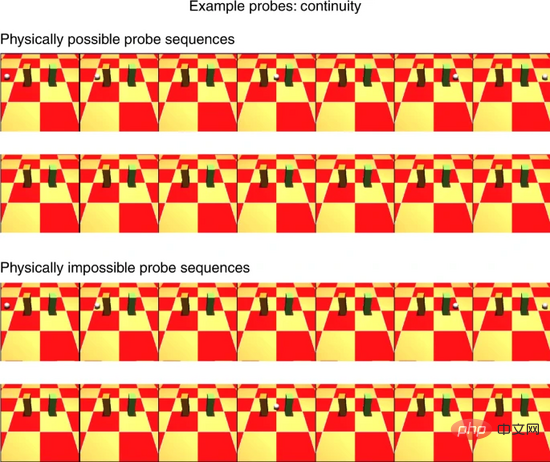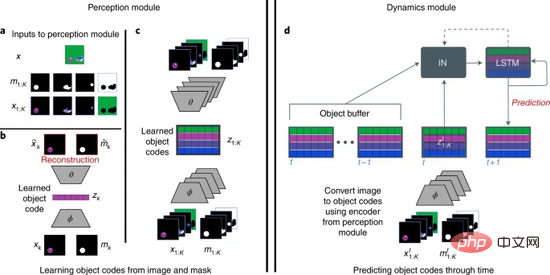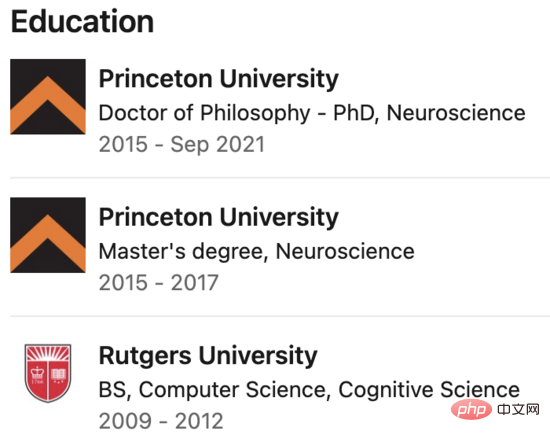 Technology peripherals
Technology peripherals
 AI
AI
 Make AI think like a baby! DeepMind 'Plato” model published in Nature sub-journal
Make AI think like a baby! DeepMind 'Plato” model published in Nature sub-journal
Make AI think like a baby! DeepMind 'Plato” model published in Nature sub-journal

Paper address: https://www.nature.com/articles/s41562-022-01394-8
However, before talking about this project, we need to Let me give an example first to make it easier for everyone to understand.
If I stand in front of you with a pen, and then I hide the pen behind my back, will you not be able to see the pen?
But the pen must still exist, right?

Such a simple truth, not only you understand it, but even a two-month-old baby understands it.
But the reason behind it is very intriguing. Scientists are curious, why do people naturally understand this principle?
The story of DeepMind starts from this simple curiosity.
Do you think babies don’t understand anything?
We call "the pen cannot be seen after being put down but the pen is still there" as one of the thousands of common sense in physics, and DeepMind scientists want to compare common sense in physics between AI and babies.
Luis Piloto of Princeton University and his colleagues developed a deep learning AI system that can understand some common-sense laws of the physical world.
In this way, future computer models can better imitate human thinking and solve problems with a model that has the same cognition as a baby.
In general, any AI model starts with a blank piece of paper, and then uses a variety of examples to train the model. From the input data and examples, the model generates knowledge.
However, scientists point out that this is not the case for babies.
Babies do not learn things from scratch, but they are born with some prejudgments about objective things.
Let’s take the hidden pen above as an example. Babies innately know that even if the pen is hidden, it will still be there.
This is the underlying logic of the next experiment. That is: babies have some core assumptions when they are born, and these assumptions will allow them to develop in the right direction as they grow up, and their knowledge will become better and better as time goes by and experience increases. Come more refined.
This gave the Piloto team inspiration.
Piloto wondered, would a deep learning artificial intelligence model that imitates infant behavior patterns perform better than an artificial intelligence model that starts with a blank sheet of paper and relies solely on experience learning?
The researchers further compared the two different models.
The first thing they did was the traditional method (referred to as a blank sheet of paper). They gave the AI model some visual animations of objects and let the AI learn, such as a block sliding down a slope, or a ball bouncing against a wall.
The AI model detected movement patterns in these animations, and the researchers then set out to test whether the model could predict the movement of other objects.
On the other hand, the artificial intelligence model that imitates babies has some "principles" at the beginning, and the source of these "principles" is some innate assumptions of babies about the movement and interaction between objects.
To give a simple example, babies know that two objects cannot pass through each other, an object cannot rise out of thin air, etc.
AI that imitates infant cognition——"Plato"
In fact, the common sense of physics that infants know innately goes beyond the two points mentioned above. The full version is the following five points:
1. Continuity: Objects do not travel from one place to another, but have a certain continuous path in time and space.
2. Object persistence: Objects will not disappear when out of sight.
3. Solidity: Objects do not penetrate each other.
4. Immutability: The properties of the object (such as shape) will not change.
5. Directional inertia: The path of object motion is consistent with the principle of inertia.

Based on these five points of knowledge, if you perform a magic trick or something for babies, and then something goes against their preset knowledge, they will know that you are doing it. They are clever and know that counter-intuitive phenomena are not the way things are.
Although, babies are still not as knowledgeable as older children. Babies will observe counter-common sense phenomena for a long time, and then compare them with their own preset cognitions, and finally conclude that someone is doing tricks. in conclusion.
Speaking of this, I can’t help but think of a very popular video. My parents hid behind the sheets, shook the sheets up and down a few times, and quickly hid in the room behind them while hiding behind the sheets. When the baby doesn't see his parents after the sheets disappear, he will stand there and think for a while, wondering where his parents have gone.
There is another interesting point here. That is, babies will express "surprise" after seeing counterintuitive phenomena. This sounds obvious, but the researchers also replicated this unique performance in AI.
With these foundations in mind, let’s look at the experimental results.
The AI model designed by Piloto is called PLATO (Physics Learning through Auto-encoding and Tracking Objects), which is "Plato".
PLATO was trained on almost 30 hours of videos showing how objects perform some simple movements, and then trained the model to predict the movements of these objects in different situations.

What’s interesting is that the model finally learned the five common sense points of physics mentioned above.
When there is something counter-intuitive in the video you are watching, PLATO can also show a certain degree of surprise like a baby.
Piloto and his colleagues found that the AI model using the traditional training method (a blank piece of paper) performed well, but it was not as good as the unknown and was shocked by the comparison. PLATO, an AI model that imitates babies, performed much better.
Because of the blessing of preset cognition, the latter model can more accurately predict the movement of an object, apply the preset cognition to new object movement animations, and train the model The size of the data set used will also be smaller.
The Piloto team concluded that although learning and experience accumulation are important, it is not everything.
Their research points directly to a classic question - what is innate in humans and what is learned.
The next step is to apply this kind of human cognition to AI research.
Piloto has shown us the excellent results of the new method.
However, Piloto emphasized that PLATO is not designed to be a baby behavior model. We are just borrowing some methods of baby cognition to feed artificial intelligence.

PLATO’s simulation system: feedforward perception module (left) and loop dynamic predictor module (right)
Jeff, a computer scientist at the University of British Columbia in Vancouver Clune also said that combining AI with the learning methods of human infants is an important direction.
At this moment, Clune is working with other researchers to develop their own algorithmic methods for understanding the physical world.
Author introduction
Luis Piloto is the first author of the paper and the corresponding author.

He received a bachelor's degree in computer science from Rutgers University in 2012, and then went to Princeton University to study, and received master's degrees in neuroscience in 2017 and 2021 respectively. Ph.D.
In 2016, he officially joined DeepMind and became a research scientist.

The above is the detailed content of Make AI think like a baby! DeepMind 'Plato” model published in Nature sub-journal. For more information, please follow other related articles on the PHP Chinese website!

Hot AI Tools

Undresser.AI Undress
AI-powered app for creating realistic nude photos

AI Clothes Remover
Online AI tool for removing clothes from photos.

Undress AI Tool
Undress images for free

Clothoff.io
AI clothes remover

Video Face Swap
Swap faces in any video effortlessly with our completely free AI face swap tool!

Hot Article

Hot Tools

Notepad++7.3.1
Easy-to-use and free code editor

SublimeText3 Chinese version
Chinese version, very easy to use

Zend Studio 13.0.1
Powerful PHP integrated development environment

Dreamweaver CS6
Visual web development tools

SublimeText3 Mac version
God-level code editing software (SublimeText3)

Hot Topics
 The top ten free platform recommendations for real-time data on currency circle markets are released
Apr 22, 2025 am 08:12 AM
The top ten free platform recommendations for real-time data on currency circle markets are released
Apr 22, 2025 am 08:12 AM
Cryptocurrency data platforms suitable for beginners include CoinMarketCap and non-small trumpet. 1. CoinMarketCap provides global real-time price, market value, and trading volume rankings for novice and basic analysis needs. 2. The non-small quotation provides a Chinese-friendly interface, suitable for Chinese users to quickly screen low-risk potential projects.
 okx online okx exchange official website online
Apr 22, 2025 am 06:45 AM
okx online okx exchange official website online
Apr 22, 2025 am 06:45 AM
The detailed introduction of OKX Exchange is as follows: 1) Development history: Founded in 2017 and renamed OKX in 2022; 2) Headquartered in Seychelles; 3) Business scope covers a variety of trading products and supports more than 350 cryptocurrencies; 4) Users are spread across more than 200 countries, with tens of millions of users; 5) Multiple security measures are adopted to protect user assets; 6) Transaction fees are based on the market maker model, and the fee rate decreases with the increase in trading volume; 7) It has won many honors, such as "Cryptocurrency Exchange of the Year".
 A list of special services for major virtual currency trading platforms
Apr 22, 2025 am 08:09 AM
A list of special services for major virtual currency trading platforms
Apr 22, 2025 am 08:09 AM
Institutional investors should choose compliant platforms such as Coinbase Pro and Genesis Trading, focusing on cold storage ratios and audit transparency; retail investors should choose large platforms such as Binance and Huobi, focusing on user experience and security; users in compliance-sensitive areas can conduct fiat currency trading through Circle Trade and Huobi Global, and mainland Chinese users need to go through compliant over-the-counter channels.
 Top 10 latest releases of virtual currency trading platforms for bulk transactions
Apr 22, 2025 am 08:18 AM
Top 10 latest releases of virtual currency trading platforms for bulk transactions
Apr 22, 2025 am 08:18 AM
The following factors should be considered when choosing a bulk trading platform: 1. Liquidity: Priority is given to platforms with an average daily trading volume of more than US$5 billion. 2. Compliance: Check whether the platform holds licenses such as FinCEN in the United States, MiCA in the European Union. 3. Security: Cold wallet storage ratio and insurance mechanism are key indicators. 4. Service capability: Whether to provide exclusive account managers and customized transaction tools.
 A list of top ten virtual currency trading platforms that support multiple currencies
Apr 22, 2025 am 08:15 AM
A list of top ten virtual currency trading platforms that support multiple currencies
Apr 22, 2025 am 08:15 AM
Priority is given to compliant platforms such as OKX and Coinbase, enabling multi-factor verification, and asset self-custody can reduce dependencies: 1. Select an exchange with a regulated license; 2. Turn on the whitelist of 2FA and withdrawals; 3. Use a hardware wallet or a platform that supports self-custody.
 Recommended top 10 for easy access to digital currency trading apps (latest ranking in 25)
Apr 22, 2025 am 07:45 AM
Recommended top 10 for easy access to digital currency trading apps (latest ranking in 25)
Apr 22, 2025 am 07:45 AM
The core advantage of gate.io (global version) is that the interface is minimalist, supports Chinese, and the fiat currency trading process is intuitive; Binance (simplified version) has the highest global trading volume, and the simple version model only retains spot trading; OKX (Hong Kong version) has the simple version of the interface is simple, supports Cantonese/Mandarin, and has a low threshold for derivative trading; Huobi Global Station (Hong Kong version) has the core advantage of being an old exchange, launches a meta-universe trading terminal; KuCoin (Chinese Community Edition) has the core advantage of supporting 800 currencies, and the interface adopts WeChat interaction; Kraken (Hong Kong version) has the core advantage of being an old American exchange, holding a Hong Kong SVF license, and the interface is simple; HashKey Exchange (Hong Kong licensed) has the core advantage of being a well-known licensed exchange in Hong Kong, supporting France
 Tips and recommendations for the top ten market websites in the currency circle 2025
Apr 22, 2025 am 08:03 AM
Tips and recommendations for the top ten market websites in the currency circle 2025
Apr 22, 2025 am 08:03 AM
Domestic user adaptation solutions include compliance channels and localization tools. 1. Compliance channels: Franchise currency exchange through OTC platforms such as Circle Trade, domestically, they need to go through Hong Kong or overseas platforms. 2. Localization tools: Use the currency circle network to obtain Chinese information, and Huobi Global Station provides a meta-universe trading terminal.
 Summary of the top ten Apple version download portals for digital currency exchange apps
Apr 22, 2025 am 09:27 AM
Summary of the top ten Apple version download portals for digital currency exchange apps
Apr 22, 2025 am 09:27 AM
Provides a variety of complex trading tools and market analysis. It covers more than 100 countries, has an average daily derivative trading volume of over US$30 billion, supports more than 300 trading pairs and 200 times leverage, has strong technical strength, a huge global user base, provides professional trading platforms, secure storage solutions and rich trading pairs.





